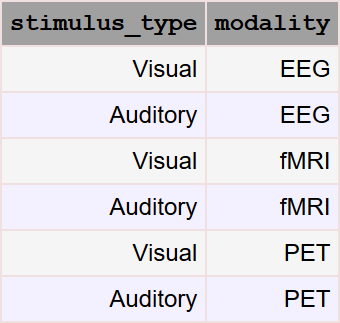Key Source¶
Default key source¶
Key source refers to the set of primary key values over which
autopopulate iterates, calling the make method at each iteration.
Each key from the key source is passed to the table's make call.
By default, the key source for a table is the join of its primary
dependencies.
For example, consider a schema with three tables.
The Stimulus table contains one attribute stimulus_type with one of two values,
"Visual" or "Auditory".
The Modality table contains one attribute modality with one of three values, "EEG",
"fMRI", and "PET".
The Protocol table has primary dependencies on both the Stimulus and Modality tables.
The key source for Protocol will then be all six combinations of stimulus_type and
modality as shown in the figure below.

Custom key source¶
A custom key source can be configured by setting the key_source property within a
table class, after the definition string.
Any query object can be used as the key source. In most cases the new key source will be some alteration of the default key source. Custom key sources often involve restriction to limit the key source to only relevant entities. Other designs may involve using only one of a table's primary dependencies.
In the example below, the EEG table depends on the Recording table that lists all
recording sessions.
However, the populate method of EEG should only ingest recordings where the
recording_type is EEG.
Setting a custom key source prevents the populate call from iterating over recordings
of the wrong type.
@schema
class EEG(dj.Imported):
definition = """
-> Recording
---
sample_rate : float
eeg_data : longblob
"""
key_source = Recording & 'recording_type = "EEG"'